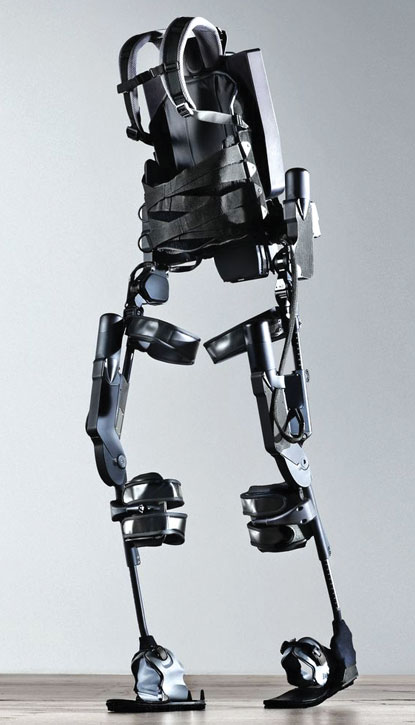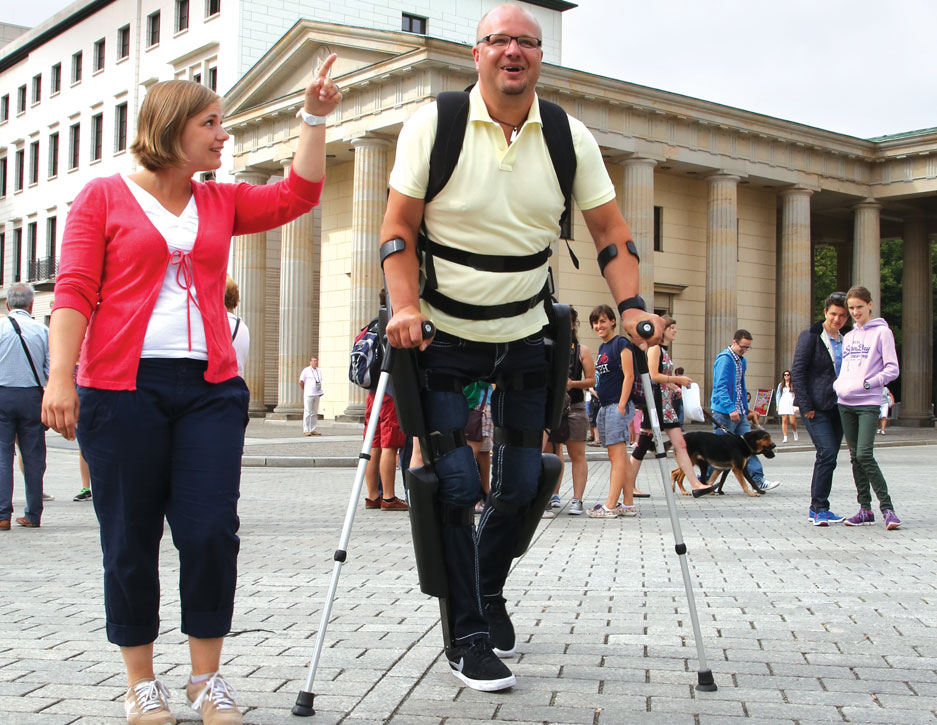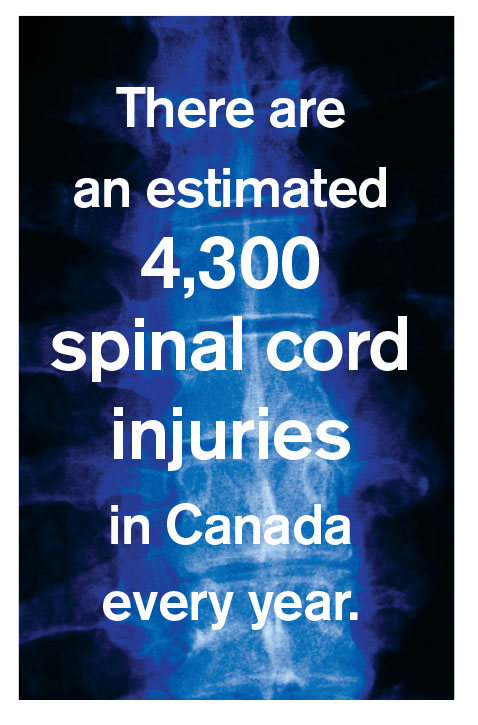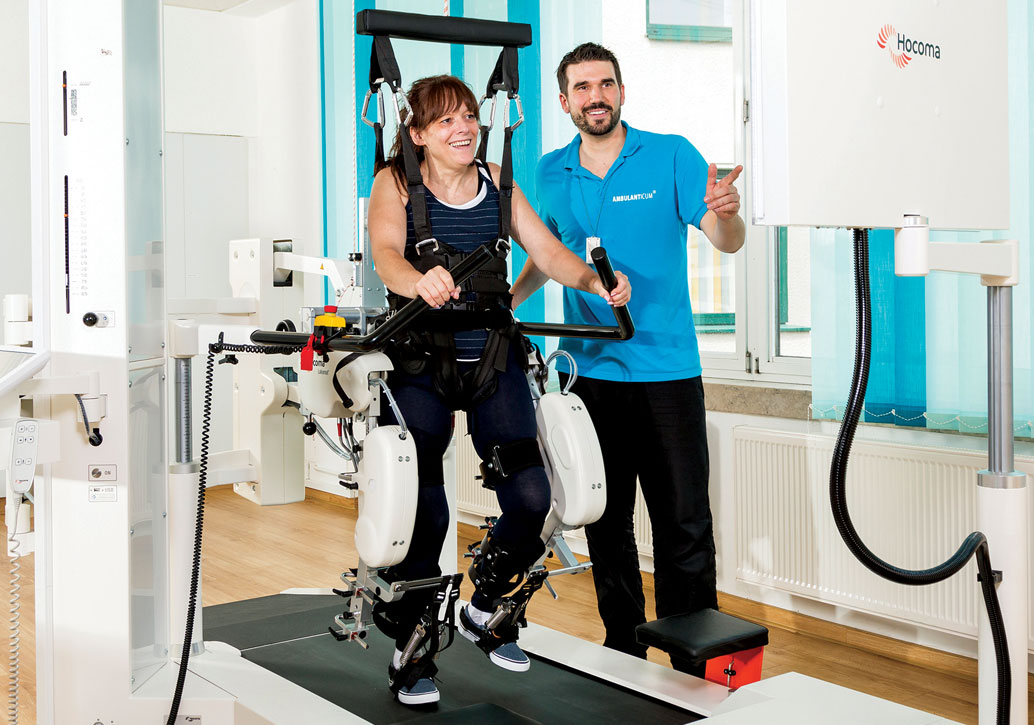A “Game-Changing” Report From the Front Lines
By Melissa Myers
 Wrapped in a black harness with clips and straps, Taylor Lindsay-Noel is wearing robotic legs and “standing” on a treadmill. Her weight-bearing gear resembles that of a rock climber’s kit. Gradually, the robotic legs begin to move as if she is walking forward. Her hips and quad muscles shake as her body’s nerves trigger in this unusual, upright position. “It feels like I’m flying like Peter Pan,” she chuckles as she swims through the air with a breaststroke motion.
Wrapped in a black harness with clips and straps, Taylor Lindsay-Noel is wearing robotic legs and “standing” on a treadmill. Her weight-bearing gear resembles that of a rock climber’s kit. Gradually, the robotic legs begin to move as if she is walking forward. Her hips and quad muscles shake as her body’s nerves trigger in this unusual, upright position. “It feels like I’m flying like Peter Pan,” she chuckles as she swims through the air with a breaststroke motion.
Lindsay-Noel, who steers her motorized wheelchair with a control stick covered by a red dome to supplement dexterity, is taking her turn on the Lokomat at Aim2Walk rehabilitation centre in Toronto. She has been coming here for therapy for roughly two years, ever since a gymnastics accident caused a spinal cord injury.
“Ordinarily, my body is trying so hard to figure out what is going on  that I get nerve pain,” she says, describing the spasticity she experiences when her body is forced into postures and movements that used to be commonplace but are now foreign.
that I get nerve pain,” she says, describing the spasticity she experiences when her body is forced into postures and movements that used to be commonplace but are now foreign.
Lindsay-Noel was 14 on July 15, 2008, the day she went to gym practice at Sport Seneca in Toronto. At the time, she was an aspiring gymnast with an Olympic-level coach. That day, her coach suggested she try a new move: the Rigby Double Front, a highly challenging dismount from the uneven bars. Lindsay-Noel recalls resisting her persistent coach for up to an hour before giving in. Her first attempt resulted in the youngster landing flat on her back. Her second try was nearly fatal. She landed on her neck, severing her spinal cord and paralyzing her body.
“It’s like my body has been between two extremes: the extreme of what it can do and the extreme of how badly it can be hurt,” she says now. The Lokomat helps improve blood circulation, reduces spasticity and keeps her legs in motion; it simulates the walking motion to help her muscles remember how to perform properly. The machine has also been shown to improve gait and balance in people with spinal cord injuries (SCI) where the injury is incomplete. But despite its wonders, the Lokomat is relatively old technology.“Ten years ago, Lokomat was the rage, and everybody needed a body-weight support treadmill,” says Dr. Catherine Craven, a physiatrist at Toronto Rehabilitation Institute who specializes in SCI. Now, she adds, treadmill training is mainstream, and there are new generation treatment innovations such as exoskeletons and stem-cell transplants.
Research Brings Innovation
Today, exoskeleton systems are all the rage, particularly a product called the ReWalk. The Spinal Cord Injury Treatment Centre (Northern Alberta) Society has purchased the first ReWalk in Canada for approximately $84,000. It’s on loan to the University of Alberta, where Jaynie Yang is charged with researching whether the device is an effective rehabilitation tool.
Yang’s study is focused on three main areas: finding out whom this device will benefit most, what type of neuroplasticity it generates, and if it’s viable for use both at home and in the community.
Study participants have to meet a number of criteria:
• injured at least a year ago
• weigh less than 220 pounds (99 kilograms)
• be within the height range of 5’3’’ to 6’4’’ (1.6 to 1.9 metres)
• use a wheelchair to get around or, if able to walk, must be capable of walking at only minimal speeds
• enough lower arm strength to support themselves on crutches
Denny Ross met all of Yang’s requirements and was selected to be part of the inaugural study. Having been a welder and an adrenalin-chasing outdoorsman, Ross was depressed and on painkillers after a workplace accident left him unable to stand or walk without aids like crutches. “I was so scared after the accident to do anything,” says Ross.
part of the inaugural study. Having been a welder and an adrenalin-chasing outdoorsman, Ross was depressed and on painkillers after a workplace accident left him unable to stand or walk without aids like crutches. “I was so scared after the accident to do anything,” says Ross.
Ross found a job with another welding company that allowed him to practice his craft while sitting, so he taught himself how to weld from his chair. However, to participate in Yang’s study he had to quit his job: “I was super-stoked the minute I heard that there was going to be a ReWalk study—or any kind of exoskeleton study—and that I could be part of it.” As a paraplegic with sufficient arm strength and residual core strength, Ross was the ideal candidate to strap on the ReWalk: “The prospect of being able to conquer my situation, and to stand up and walk around every now and again,” he explains, “has been wonderful.”
“It’s a lot of work when you first start,” says Ross. “Once you get it figured out, it gets a bit easier, to the point where you can more or less let the suit do the work and just rely on your crutches more like little outriggers.”
Ross recounts with glee the first time he used the device: Sitting strapped to the ReWalk that’s held to him by backpack, pelvic and leg straps, he toggled the wristband remote to the “stand” position. Next he readied his crutches, holding them slightly wider than shoulder distance apart. Then, after pushing a button that caused a buzzer on the backpack to beep and buzz in his ear, the machine leaned forward and moved into a standing position. Fear and excitement gripped him as he felt his equilibrium being thrown off balance. He recalls thinking he had, at that moment, become a pioneer. Upon selecting the “walk” button and leaning forward to initiate the first step, his immediate thought was, “Escaping with it!”
He realized that coordination is key, as he shifted his weight to the opposite side and positioned himself to allow his second leg to clear his crutches and the ground. As he shifted his weight again to trigger the third step, his whole self breathed: “Finally!”
Cost and Effectiveness?
Various studies have documented the mental as well as physical benefits of these types of devices. “I think exoskeletons are going to be a game-changer,” says Craven. “There’s lots of rehab technologies in the past 20 years that have come and gone and come and gone […], but [the] functional abilities [of people with SCIs] with and without the device are just so different.”
Craven admits that exoskeleton devices are still wildly out of reach, financially, for most people. But, she adds, they need to be looked at closely, given the difference they can make in improving quality of life. Funding is being considered by workers’ compensation boards, but it will be a while yet—if ever—before these newer technologies become financially accessible through provincial health-insurance plans.
As well, exoskeleton devices are not suitable for all types of SCIs. Lindsay-Noel, for example, was left a quadriplegic by her accident and lacks the upper-body strength required to operate an exoskeleton. The Lokomat technology, which some workers’ compensation boards will fund, is the only one that currently allows her to escape from the chair and return to her feet. “I’m fully willing to try anything physical-wise and different types of therapies, different methodologies,” she says. “I’m very open to everything, because I want to give my body the best chance.”
Ready for change
Encouraging news from Poland saw a paralyzed man regain his ability to walk after a cell transplant from inside his nostril to his spinal cord. However, Lindsay-Noel says she isn’t willing to be a guinea pig, but at her young age she’s hopeful scientific advancements will improve significantly within her lifetime. “That’s why I’m doing therapy, to keep my body healthy so that when that day comes, I’m ready and my body’s ready as well,” she says.
For Ross, having a personal exoskeleton not only seems like a viable option, it’s a goal. “I would enjoy it fully,” he says. “I’d go out and walk around on the trails with my kids. They could ride their bikes and we could take the dog.”
Melissa Myers is a freelance journalist and video producer. She is also a journalism student at Ryerson University who has covered the food, health and wellness beats for a number of years.














